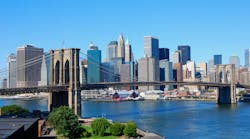From New York to California, state and local governments are implementing green building criteria as policy to lessen the built environment’s impact on climate change.
These so-called “green building” strategies are taking a more prominent place in traditional building codes as they seek to address categories of indoor environmental quality, energy efficiency, conservation of resources, renewables and more. From East to West, new strategies to become carbon neutral are going into effect.
New York City: Local Law 97
Two-thirds of greenhouse gasses in New York City reportedly come from existing buildings. The Climate Mobilization Act was passed in April 2019 as part of the city’s plan for a “Green New Deal.” Most new and existing buildings over 25,000 square feet are impacted by Local Law 97, which requires building owners and operators to adhere to new energy efficiency and greenhouse gas emissions limits by 2024. The law generally covers (with some exceptions) the following:
- Buildings larger than 25,000 gross square feet
- Two or more buildings on the same tax lot that combined exceed 50,000 square feet
- Two or more buildings owned by a condo association and governed by the same board of managers that together total more than 50,000 square feet
While the compliance burden goes to the owners of these structures, tenants should also be aware of the potential impact Local Law 97 can have on future lease negotiations. Tenants are encouraged to pay special attention to term sheet negotiations with prospective or current landlords, including the following questions:
- Have there been any efficiency audits conducted by the building owner/operator to assess building systems?
- What steps are being taken to address Local Law 97 requirements?
- Will the cost of compliance be passed on to tenants through rent increases or other provisions?
- What green lease provisions (if any) are included in the landlord’s contract?
Asking these questions is especially important for multi-tenant buildings. Renters should also note any operating expense provisions that may include pass-through of certain expenses to the occupant. Working together, tenants and owners/operators have a better chance of meeting the overall goal to cut building emissions in New York by 40% by 2030 and 80% by 2050. The Department of Buildings (DOB) Greenhouse Gas Emission Reporting website has more information emissions limits as well as clarification about which buildings are exempt from the New York law.
Chicago: Major Building Code Revision
In its first major revision since 1949, the Chicago City Council approved an update to the city’s building code in 2019. New regulations streamline cost-effective construction and expands the number of options for designs and building materials. The new code also promotes greater use of green technologies and best practices for sustainable building design and construction.
More recently, the Chicago Building Code was further revised to update energy efficiency and sustainable design requirements to align with requirements adopted by the state and established by the International Energy Conservation Code (IECC).
The city has also published a Chicago Sustainable Development Policy Handbook to help guide development projects to adopt sustainable strategies.
Denver: The Denver Green Code
The Mile-High City is living up to its nickname by setting high standards for achieving sustainability. Denver is seeking to cut greenhouse gas emissions by 90% by 2050. To hit that goal, the city must find ways to eliminate 100 million tons of carbon emissions each year. Under recent building code regulations, facility owners are required to either cover 70% of their roofs with solar panels or source renewable electricity off-site if the building location does not adequately support solar power.
In addition to new guidelines, Denver is encouraging building owners to go above and beyond the minimum requirements. The city launched the Denver Green Code in November 2019—a voluntary set of guidelines for pilot projects that is based on the International Green Construction Code and is 10% better than existing city codes. Developers can benefit in different ways when they adopt the Denver Green Code. These advantages include expedited permitting of projects. This initiative offers compliance options for LEED Platinum and net zero building certifications.
San Francisco: CALGreen/SFGBC
The goal of the California Green Building Code (CALGreen) is to set building regulations to optimize environmental preservation. CALGreen and local requirements are collectively known as the San Francisco Green Building Code (SFGBC). Regularly updated to maintain alignment with California Green Building Standards Code, the SFGBC also calls for stricter local requirements, such as:
- New construction restricted to being all electric
- For new buildings 10 floors in height or less, mandated installation of solar electric, thermal or green roof features
- Provide on-site facilities for collection and conveyance of compost, in addition to recycling
- Buildings specifically wired to supply electricity for electric vehicle charging at 100% of new parking spaces
- Meet city green building requirements tied to the LEED and GreenPoint Rated green building rating systems
The California Building Standards Commission (CBSC) is also authorized to propose CALGreen standards for “nonresidential structures that include new buildings or portions of new buildings, additions and alterations, and all occupancies where no other state agency has the authority to adopt green building standards applicable to those occupancies.”
Other Cities Follow
Major cities may be leading the initiative; however, the rest of the country seems to be focused on a cleaner, more efficient and healthy built environment as well. Building owners, operators and occupants need to work together to for these efforts to be successful while the engineering design and construction industries continue to push for a greener, more sustainable future.
About the Author:
Ryann Menges is the operations director for global engineering firm ESD and heads up the New York office. She is responsible for leading a team of engineers and delivering complex projects with mission critical infrastructure. Ryann is a licensed Professional Engineer (PE) and is actively involved in the local chapters of CoreNet Global and IFMA (International Facility Management Association).



